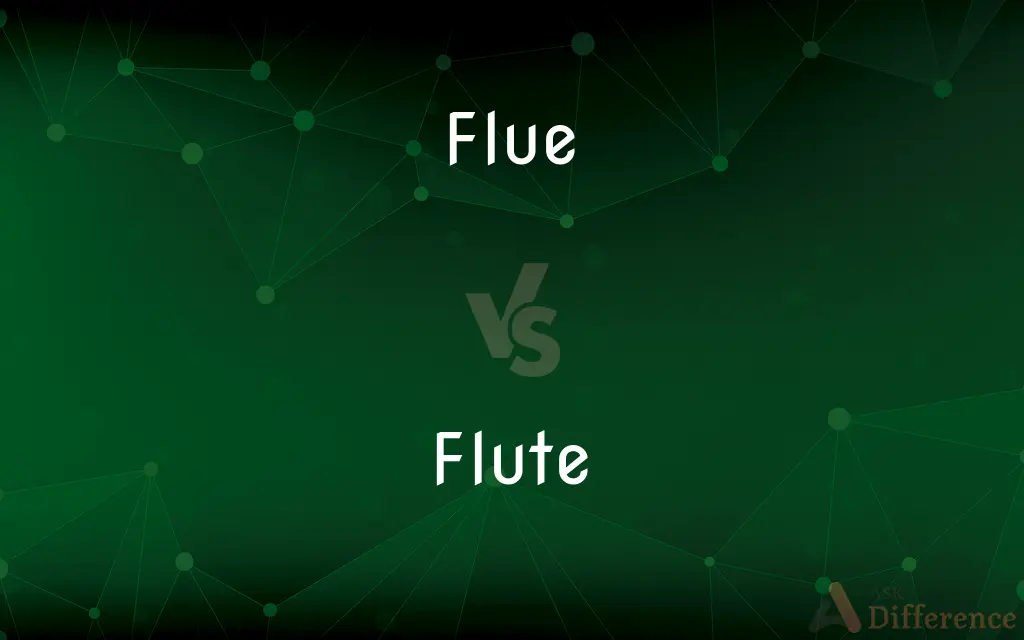Flue vs. Flute — What's the Difference?
Edited by Tayyaba Rehman — By Urooj Arif — Updated on April 26, 2024
Flue channels smoke and gases in buildings, focusing on ventilation, whereas a flute is a musical wind instrument known for melodic sounds.

Difference Between Flue and Flute
Table of Contents
ADVERTISEMENT
Key Differences
A flue is an integral part of a home or industrial building, used to vent smoke and gases safely to the outside, whereas a flute is a musical instrument that produces sound when air is blown across an opening.
Flues are typically constructed from materials like metal or clay that can withstand high temperatures, whereas flutes are usually made from materials such as wood, metal, or plastic depending on the desired sound quality and durability.
The design of a flue is primarily functional, emphasizing safety and efficiency in directing gases away from interior spaces, whereas the design of a flute focuses on musical tone and playability.
Maintenance of a flue involves regular cleaning to prevent blockages and ensure efficient operation, whereas maintaining a flute includes cleaning, adjusting, and occasionally replacing pads to keep it in good playing condition.
The use of flues is essential in systems like heating and fireplace exhausts, highlighting their role in health and safety, while flutes are used in various musical contexts, from orchestras to solo performances, showcasing their artistic value.
ADVERTISEMENT
Comparison Chart
Primary Use
Venting gases from buildings
Musical performance
Material
Metal, clay
Wood, metal, plastic
Design Focus
Safety, efficiency in gas exhaust
Sound quality, playability
Maintenance Needs
Regular cleaning to prevent blockages
Cleaning, pad replacement, adjustment
Context of Use
Heating systems, fireplaces
Orchestras, bands, solo performances
Compare with Definitions
Flue
In industrial settings, flues are critical components of the exhaust system.
The factory's flue was visible, emitting steam into the cold air.
Flute
The flute is a family of musical instruments in the woodwind group. Unlike woodwind instruments with reeds, a flute is an aerophone or reedless wind instrument that produces its sound from the flow of air across an opening.
Flue
The size and design of a flue depend on its intended use and the appliances connected.
The new boiler required a larger flue to handle increased output.
Flute
A wind instrument made from a tube with holes that are stopped by the fingers or keys, held vertically or horizontally (in which case it is also called a transverse flute) so that the player's breath strikes a narrow edge. The modern orchestral form is a transverse flute, typically made of metal, with an elaborate set of keys.
Flue
A duct, pipe, or chimney for conveying exhaust gases from a fireplace, furnace, water heater, or boiler to the outdoors.
The house's flue needs cleaning to prevent soot build-up.
Flute
An ornamental vertical groove in a column.
Flue
A flue functions to prevent the backflow of exhaust and combustion particles.
They installed a new flue to improve the efficiency of the heating system.
Flute
A tall, narrow wine glass
A flute of champagne
Flue
Flues must be properly sealed to prevent leakage of potentially harmful gases.
The technician checked the flue for any signs of damage or leaks.
Flute
Play a flute or pipe.
Flue
A flue is a duct, pipe, or opening in a chimney for conveying exhaust gases from a fireplace, furnace, water heater, boiler, or generator to the outdoors. Historically the term flue meant the chimney itself.
Flute
Make flutes or grooves in.
Flue
A duct for smoke and waste gases produced by a fire, a gas heater, a power station, or other fuel-burning installation
No air rises up the chimney, usually because the flue is blocked
Flue gases
Flute
A high-pitched woodwind instrument consisting of a slender tube closed at one end with keys and finger holes on the side and an opening near the closed end across which the breath is blown. Also called transverse flute.
Flue
A pipe, tube, or channel for conveying hot air, gas, steam, or smoke, as from a furnace or fireplace to a chimney.
Flute
Any of various similar reedless woodwind instruments, such as the recorder.
Flue
An organ pipe sounded by means of a current of air striking a lip in the side of the pipe and causing the air within to vibrate. Also called labial.
Flute
An organ stop whose flue pipe produces a flutelike tone.
Flue
The lipped opening in such a pipe.
Flute
(Architecture) A long, usually rounded groove incised as a decorative motif on the shaft of a column, for example.
Flue
A fishing net.
Flute
A similar groove or furrow, as in a pleated ruffle of cloth or on a piece of furniture.
Flue
A pipe or duct that carries gaseous combustion products away from the point of combustion (such as a furnace).
Flute
A tall narrow wineglass, often used for champagne.
Flue
An enclosed passageway in which to direct air or other gaseous current along.
Flute
(Music) To play (a tune) on a flute.
Flue
A woolly or downy substance; down, nap; a piece of this.
Flute
To produce in a flutelike tone.
Flue
In an organ flue pipe, the opening between the lower lip and the languet.
Flute
To make flutes in (a column, for example).
Flue
An inclosed passage way for establishing and directing a current of air, gases, etc.; an air passage
Flute
(Music) To play a flute.
Flue
In an organ flue pipe, the opening between the lower lip and the languet.
Flute
To sing, whistle, or speak with a flutelike tone.
Flue
Light down, such as rises from cotton, fur, etc.; very fine lint or hair.
Flute
A woodwind instrument consisting of a tube with a row of holes that produce sound through vibrations caused by air blown across the edge of the holes, often tuned by plugging one or more holes with a finger; the Western concert flute, a transverse side-blown flute of European origin.
Flue
Flat blade-like projection on the arm of an anchor
Flute
(colloquial) A recorder, also a woodwind instrument.
Flue
Organ pipe whose tone is produced by air passing across the sharp edge of a fissure or lip
Flute
A glass with a long, narrow bowl and a long stem, used for drinking wine, especially champagne.
Flue
A conduit to carry off smoke
Flute
A lengthwise groove, such as one of the lengthwise grooves on a classical column, or a groove on a cutting tool (such as a drill bit, endmill, or reamer), which helps to form both a cutting edge and a channel through which chips can escape
Flute
A semicylindrical vertical groove, as in a pillar, in plaited cloth, or in a rifle barrel to cut down the weight.
Flute
A long French bread roll, baguette.
Flute
An organ stop with a flute-like sound.
Flute
A shuttle in weaving tapestry etc.
Flute
A kind of flyboat; a storeship.
Flute
(intransitive) To play on a flute.
Flute
(intransitive) To make a flutelike sound.
Flute
(transitive) To utter with a flutelike sound.
Flute
(transitive) To form flutes or channels in (as in a column, a ruffle, etc.); to cut a semicylindrical vertical groove in (as in a pillar, etc.).
Flute
A musical wind instrument, consisting of a hollow cylinder or pipe, with holes along its length, stopped by the fingers or by keys which are opened by the fingers. The modern flute is closed at the upper end, and blown with the mouth at a lateral hole.
The breathing flute's soft notes are heard around.
Flute
A similar channel or groove made in wood or other material, esp. in plaited cloth, as in a lady's ruffle.
Flute
A long French breakfast roll.
Flute
A stop in an organ, having a flutelike sound.
Flute
A kind of flyboat; a storeship.
Flute
To play on, or as on, a flute; to make a flutelike sound.
Flute
To play, whistle, or sing with a clear, soft note, like that of a flute.
Knaves are men,That lute and flute fantastic tenderness.
The redwing flutes his o-ka-lee.
Flute
To form flutes or channels in, as in a column, a ruffle, etc.
Flute
A high-pitched woodwind instrument; a slender tube closed at one end with finger holes on one end and an opening near the closed end across which the breath is blown
Flute
A tall narrow wineglass
Flute
A groove or furrow in cloth etc especially the shallow concave groove on the shaft of a column
Flute
Form flutes in
Flute
A woodwind instrument consisting of a tube with holes covered by keys.
She played a beautiful melody on her silver flute.
Flute
The flute produces sound when air is blown across the edge of the mouthpiece.
He learned to direct his breath precisely to create a clear tone on the flute.
Flute
Flutes vary in size and pitch, including piccolos and bass flutes.
The orchestra's flautist also played the piccolo in several pieces.
Flute
Modern flutes are typically made from metals such as silver or gold for better sound.
Her golden flute had a warm, rich tone compared to standard instruments.
Flute
Mastery of the flute requires control of breathing and finger dexterity.
Daily practice improved her fluency and control over the flute's complex fingerings.
Common Curiosities
What materials are flues commonly made from?
Flues are commonly made from materials capable of withstanding high temperatures, such as metal or clay.
What skills are necessary to play the flute?
Playing the flute requires good breath control, finger dexterity, and the ability to read music.
What is the purpose of a flue in a building?
A flue is used to safely vent smoke and harmful gases from appliances like furnaces and fireplaces to the outside of a building.
How often should a flue be cleaned?
A flue should be cleaned at least once a year to prevent blockages and maintain proper function.
What safety concerns are associated with flues?
Safety concerns with flues include the risk of carbon monoxide poisoning if not properly installed and maintained.
Can a flute be made of plastic?
Yes, flutes can be made of plastic, which are especially common for beginner instruments due to their durability and lower cost.
How does a flute produce sound?
A flute produces sound by blowing air across the mouthpiece, causing the air within the tube to vibrate.
What are the different types of flutes?
Different types of flutes include the concert flute, piccolo, and bass flute, each varying in size and pitch.
Is a flue visible outside the building?
Yes, the part of the flue that vents to the outside is often visible on the roof or side of a building.
How do different flute materials impact maintenance?
Different materials require different maintenance strategies; for instance, wooden flutes may need more care to prevent moisture damage compared to metal flutes.
Why is it important to maintain a flue?
Maintaining a flue is crucial to prevent fire hazards and ensure that toxic gases are safely vented out of the dwelling.
How does the material of a flute affect its sound?
The material of a flute affects its sound quality, with metals like silver and gold providing richer and more resonant tones.
How does one choose the right size of flue?
Choosing the right size of flue involves considering the output and type of the heating appliance to ensure efficient and safe operation.
What is the difference between a flue and a duct?
A flue specifically vents exhaust gases and heat, while a duct is used more broadly for distributing air within buildings.
Are there electronic versions of flutes?
Yes, there are electronic flutes, or "E-flutes," which simulate traditional flute sounds digitally and can have additional features.
Share Your Discovery

Previous Comparison
Note vs. Record
Next Comparison
Extravagant vs. FlamboyantAuthor Spotlight
Written by
Urooj ArifUrooj is a skilled content writer at Ask Difference, known for her exceptional ability to simplify complex topics into engaging and informative content. With a passion for research and a flair for clear, concise writing, she consistently delivers articles that resonate with our diverse audience.
Edited by
Tayyaba RehmanTayyaba Rehman is a distinguished writer, currently serving as a primary contributor to askdifference.com. As a researcher in semantics and etymology, Tayyaba's passion for the complexity of languages and their distinctions has found a perfect home on the platform. Tayyaba delves into the intricacies of language, distinguishing between commonly confused words and phrases, thereby providing clarity for readers worldwide.
















































